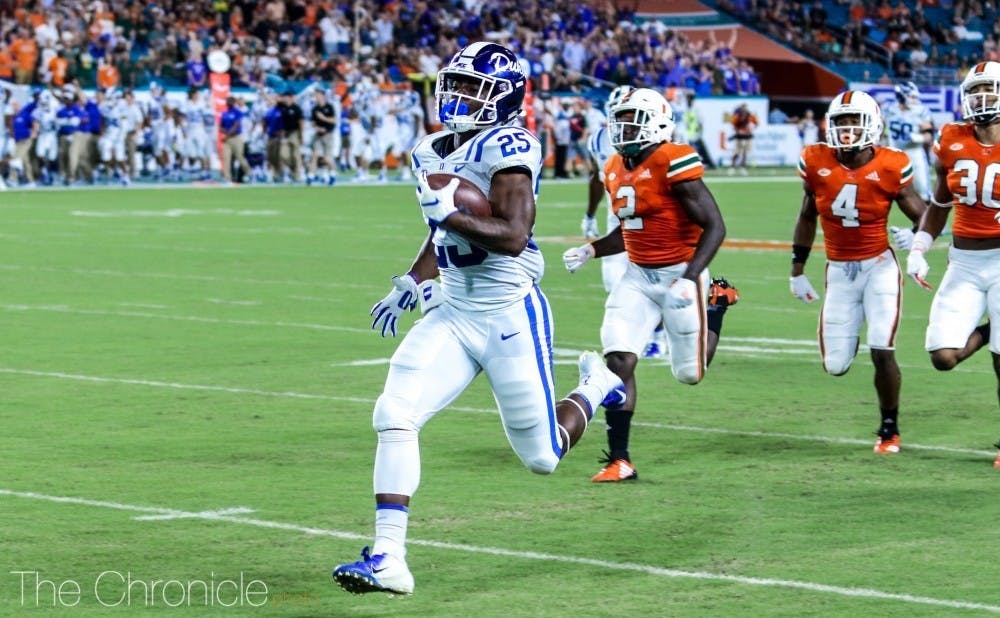Coming off a 41-18 road victory over Middle Tennessee and a bye week, Duke enters ACC play looking to contend in the Coastal Division. A road trip to face Virginia Tech presents a difficult challenge, as the Hokies have one of the loudest home environments in college football.
Virginia Tech head coach Justin Fuente is currently in his fourth season at the helm after taking over for the legendary Frank Beamer. Fuente has gone 27-16 during his tenure in Blacksburg, but the Hokies regressed to a record of 6-7 (4-4 in the ACC) in 2018 and are 2-1 in the early stages of the 2019 season. Fuente is seen as a bright offensive mind by many in the coaching community.
Virginia Tech utilizes a spread offense that features a significant amount of four and five receiver sets as well as a heavy dosage of the perimeter run game. Redshirt senior quarterback Ryan Willis is in his second year as the starter in Blacksburg, and offensive coordinator Brad Cornelsen gives Willis the freedom to scan the field. Willis has struggled so far in 2019, however, with a QBR of 41.3 that ranks 105th nationally.
The Hokies utilize spread formations and concepts to force the opposing defense to cover the entire field, creating mismatches that Willis is tasked with exploiting. The use of misdirection in the backfield puts the opposing defense out of position, allowing Virginia Tech to utilize an effective screen game. The constant threat of the screen allows a backside receiver in motion to create a running lane if Willis decides to hand the ball off on a zone read. Willis’ job on these zone reads is to determine whether the strong side defensive end is crashing down towards the center. If the end decides to crash, then Willis should keep the ball and run off tackle.
Virginia Tech constantly uses pre-snap motion to shift the linebackers and safeties at the second level, subsequently isolating receivers on the outside. The motion can lead to a fake to the slot receiver coming across the formation, allowing for the outside receiver to have a simple matchup against the cover corner. Willis shows poise in the pocket and often leads the receiver towards the middle of the field, hitting him in stride before the defender can make contact.
Defensive coordinator Bud Foster is currently in his 25th and final season as Virginia Tech’s defensive play-caller, famous for his 4-2-5 style and complex defensive fronts that bring pressure from a variety of positions. The Hokie defense is well known for the Rover position, which is a hybrid linebacker/safety who can rush the passer, tackle in space and drop back into coverage. Foster often disguises the direction that the blitz is coming from, exploiting miscommunication amongst the opposing offensive line. By having corners blitz off the edge and having the safeties line up closer to the line of scrimmage, Virginia Tech gives its athletic blitzers the chance to create havoc in the backfield.
Virginia Tech can also show the possibility of a blitz and subsequently drop back into an eight man zone look. This helps to prevent big plays from developing down the field. Against a running quarterback that can break contain, the Hokie secondary is tasked with maintaining discipline with regards to gap control. Virginia Tech also diversifies the method of attack that its defensive line takes, with multiple fronts and angles utilized to create edge pressure. With the defensive line that is slanting, a blitzing rover can find a crease in the offensive line and get to the quarterback. This strategy up front further puts the onus on the secondary to prevent the receivers from finding soft spots in the zone coverage. Foster’s extensive experience gives the Hokie defenders a sense of trust in their schemes as well.
The Blue Devils will once again put their trust in quarterback Quentin Harris to handle the aggressive and disciplined Virginia Tech defense. Harris—who boasts a touchdown-to-interception ratio of four to one so far in the season—will again need to limit turnovers to ensure that Duke has the best opportunity to snag a key road conference win.
Look for Deon Jackson to also play a major role in both the running and passing games. Overall, the Blue Devils will be able to evolve and grow as a team in a difficult road environment against a traditional ACC power.
Get The Chronicle straight to your inbox
Signup for our weekly newsletter. Cancel at any time.

Max Rego is a Trinity senior and an associate sports editor for The Chronicle's 118th volume. He was previously sports managing editor for Volume 117.

